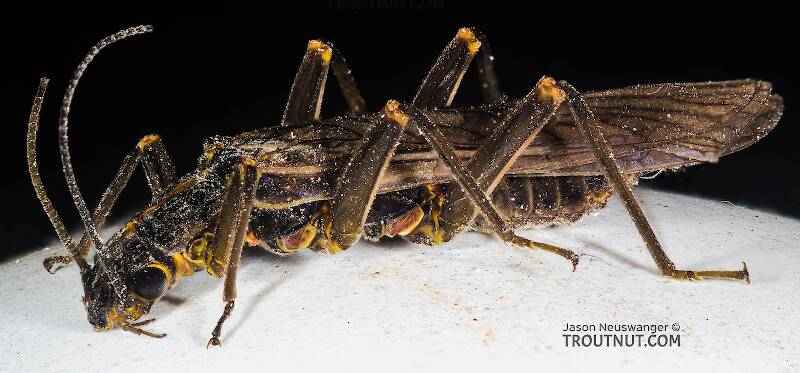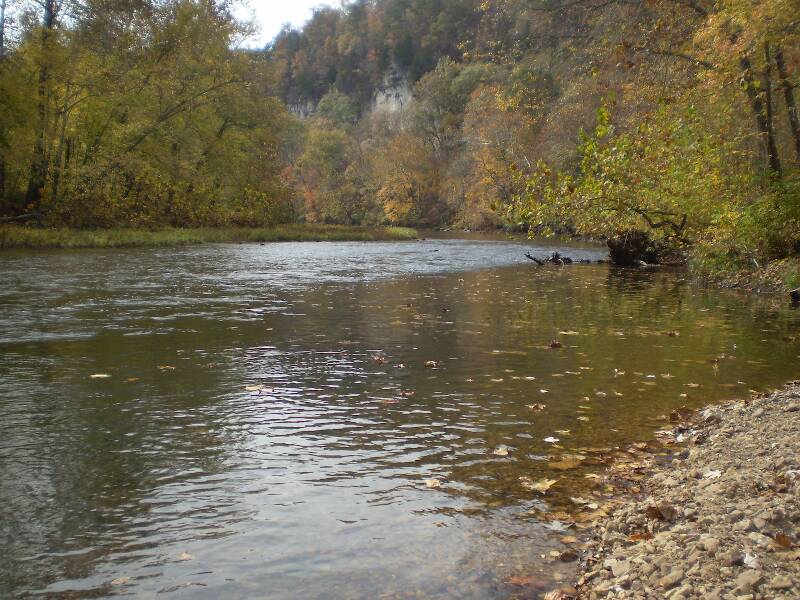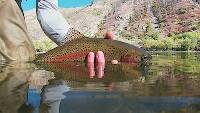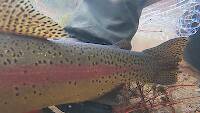
Salmonflies
Pteronarcys californica
The giant Salmonflies of the Western mountains are legendary for their proclivity to elicit consistent dry-fly action and ferocious strikes.
Featured on the forum

Troutnut is a project started in 2003 by salmonid ecologist Jason "Troutnut" Neuswanger to help anglers and
fly tyers unabashedly embrace the entomological side of the sport. Learn more about Troutnut or
support the project for an enhanced experience here.
Oldredbarn on Jul 23, 2010July 23rd, 2010, 4:25 am EDT
I need some scientific support here...If it exists...
Those of you that have paid attention to some of my posts know I have been a vegetarian since I was 16...40 years ago. I practise catch-and-release and last ate a trout in the late 60's...
It is important, when we practise catch-and-release, to handle the trout with care...Don't over play it, don't handle it out of the water for too long etc...Don't hassle them when the water temps are elevated.
My question is about "giving them the fly"...We all carry hemo's for those times when a fish takes a fly deep and it's difficult to remove it. I have a counting system where, in my head I count, or will only give it one good try before I cut the tippet as close to the fly as possible and let the fish go. This system is for trout primarily.
The question...What happens to the fly & hook after the fish is released? Does it actually harm a fish or does it dissolve with time (the wives tale part)?
In my recent post about Bluegill fishing on Beaver Island I used some pretty gaudy attractor flys and those aggressive gills' eyes were bigger that their stomachs, or throats for that matter, and I had a-hell-of-a-time removing some flies. Some of them sucked in the flies I used and I just couldn't extract them without harm to the fish...
I have had conversations with people after telling them the story of my fishing trip and when I mention that the hook eventually dissolves they look at me skeptically...
Spence
Those of you that have paid attention to some of my posts know I have been a vegetarian since I was 16...40 years ago. I practise catch-and-release and last ate a trout in the late 60's...
It is important, when we practise catch-and-release, to handle the trout with care...Don't over play it, don't handle it out of the water for too long etc...Don't hassle them when the water temps are elevated.
My question is about "giving them the fly"...We all carry hemo's for those times when a fish takes a fly deep and it's difficult to remove it. I have a counting system where, in my head I count, or will only give it one good try before I cut the tippet as close to the fly as possible and let the fish go. This system is for trout primarily.
The question...What happens to the fly & hook after the fish is released? Does it actually harm a fish or does it dissolve with time (the wives tale part)?
In my recent post about Bluegill fishing on Beaver Island I used some pretty gaudy attractor flys and those aggressive gills' eyes were bigger that their stomachs, or throats for that matter, and I had a-hell-of-a-time removing some flies. Some of them sucked in the flies I used and I just couldn't extract them without harm to the fish...
I have had conversations with people after telling them the story of my fishing trip and when I mention that the hook eventually dissolves they look at me skeptically...
Spence
"Even when my best efforts fail it's a satisfying challenge, and that, after all, is the essence of fly fishing." -Chauncy Lively
"Envy not the man who lives beside the river, but the man the river flows through." Joseph T Heywood
"Envy not the man who lives beside the river, but the man the river flows through." Joseph T Heywood
Windknot79 on Jul 23, 2010July 23rd, 2010, 5:16 am EDT
Spence I would think that the fly would get in the way of feeding and the fish would die.I don't know how long in freshwater it would take for the hook to rust out either.I guess it would depend also as to were the fly is in the fishes mouth.I carry two different size forceps so I can get the hook out.
I will start a little science experiment today and put a fly in water and see how long it takes out rust out.
mike.
I will start a little science experiment today and put a fly in water and see how long it takes out rust out.
mike.
Oldredbarn on Jul 23, 2010July 23rd, 2010, 6:21 am EDT
I will start a little science experiment today and put a fly in water and see how long it takes to rust out.
Mike,
Part of the "myth" is that the fish secretes an enzyme that facilitates the process of dissolution...
I think we humans have a tendency to believe what sets well with our view of the world...That includes vego-fly-fishing guys like me...
I was in Berlin in 1987 and went in to a cafe for German potato pancakes...I explained I was a vegetarian and wanted just butter with it and a cold Pils...They were wonderful! A few days later I was in the same neighborhood and went in again...I had a different waitress and I re-explained everything to her and she said "Nein"..."You told me you were a vegetarian and we cook our Kartoffelpuffer mit goose drippings..." What was I to do???
Moral luggage is moral luggage...No?!
Spence
"Even when my best efforts fail it's a satisfying challenge, and that, after all, is the essence of fly fishing." -Chauncy Lively
"Envy not the man who lives beside the river, but the man the river flows through." Joseph T Heywood
"Envy not the man who lives beside the river, but the man the river flows through." Joseph T Heywood
Jmd123 on Jul 23, 2010July 23rd, 2010, 8:21 am EDT
I have often wondered about the hook dissolving on it's own because of powerful digestive juices, etc. Well, the only way I would know how to prove or disprove this would be, quite literally, to bring deep-hooked fish back to an aquarium and see what happens! Of course, you would need to have an aerated bucket to immediately place the fish into and make sure that absolutely minimal trauma (other than having a hook impaled in its thoat) occurs to the fish during the transporation process...But, this would perhaps finally answer the question.
I DO know that if you take your time working out a deep hook, the fish sure as hell isn't going to make it!
I had a bit of a dilemma on the Maple River in June. I caught a nice 12" brown that was hooped in the tongue, and bleeding profusely enough to turn my White Wulff into a Red Wulff! I debated killing him and taking him home - he was legal size for the stream - but I ended up letting him go, partially because I had left my creel in the car (haven't actually used it yet) and partially because I didn't think he was wounded all that badly. And, also, I am just not in the habit of killing fish these days! I suspect the fish probably made it...Once, though, I did have to leave a fly stuck in the tongue of a sea-run cutthroat trout in Oregon - not sure if that one made it, especially since he wasn't a big fish and the fly wasn't exactly small...
Jonathon
P.S. At least in fly fishing I have found many fewer fish swallow the hook than in my old baitfishing days. And, you don't have three trebels to extract either!!
I DO know that if you take your time working out a deep hook, the fish sure as hell isn't going to make it!
I had a bit of a dilemma on the Maple River in June. I caught a nice 12" brown that was hooped in the tongue, and bleeding profusely enough to turn my White Wulff into a Red Wulff! I debated killing him and taking him home - he was legal size for the stream - but I ended up letting him go, partially because I had left my creel in the car (haven't actually used it yet) and partially because I didn't think he was wounded all that badly. And, also, I am just not in the habit of killing fish these days! I suspect the fish probably made it...Once, though, I did have to leave a fly stuck in the tongue of a sea-run cutthroat trout in Oregon - not sure if that one made it, especially since he wasn't a big fish and the fly wasn't exactly small...
Jonathon
P.S. At least in fly fishing I have found many fewer fish swallow the hook than in my old baitfishing days. And, you don't have three trebels to extract either!!
No matter how big the one you just caught is, there's always a bigger one out there somewhere...
GONZO on Jul 23, 2010July 23rd, 2010, 9:53 am EDT
There may be an element of myth about the notion of hooks rusting out or being dissolved by digestive juices. My understanding is that when a fish sheds a hook, the mechanism is more likely to be festering. FWIW, here is a take on the subject from the PAF&BC website:
A much higher percentage of fish that are hooked deeply survive when the hook is left in and the line cut compared to those where a deep hook is removed. In the few scientific studies where the fate of hooks that were left in fish released by anglers were tracked, it has been learned that hooks were eventually shed by the fish or surrounded by new tissue. One study found that rainbow trout shed hooks in about 40 days. The study of 200 hundred trout released without removal of hooks 66 percent survived, of the 200 where the hook was removed 11.5 percent survived.
In a 1989 study of smallmouth bass, study mortality ranged between 32.5 and 47.3 percent (depending upon hook size) for hooks that were immediately removed, whereas mortality for hooks that were not removed was 4.2 percent. In the case of juvenile smallmouth bass, the study found that upon dissection, some hooks were lodged in internal organs but that new tissue surrounded the hooks. The study further noted that dissected hooks exhibited minimal corrosion after 20 days.
You are wise to cut the line and leave the hook in, the fish will likely survive to be caught another day.
Jmd123 on Jul 23, 2010July 23rd, 2010, 11:22 am EDT
THANKS for that info, GONZO. Now I know I've been doing the right thing all along.
Jonathon
Jonathon
No matter how big the one you just caught is, there's always a bigger one out there somewhere...
Troutnut on Jul 23, 2010July 23rd, 2010, 11:52 am EDT
Here's some more confirmation of what Gonzo said. At the symposium on salmonids in Spain this past May, I saw a talk on some excellent recent research on this subject in Japan. Here's part of the Web of Science record for the corresponding article (abstract in bold):
Long story short: Cut the line, and the fish will probably be fine.
This study was done with live bait on bare hooks, so I do have to wonder how these results would be complicated by having a fly attached to the hook. That could warrant an additional study. My best guess is that the fly would deteriorate quickly enough that it wouldn't be harmful, but that's just a guess.
I found some other interesting stuff in that same talk, and while searching for the papers online, but I'll spin those off into their own topics.
Author(s): Tsuboi, J; Morita, K; Ikeda, H
Title: Fate of deep-hooked white-spotted charr after cutting the line in a catch-and-release fishery
Source: FISHERIES RESEARCH, 79 (1-2): 226-230 JUN 2006
Abstract: Using wild white-spotted charr (Salvelinus leucomaenis) as a model, we investigated the effects of cutting the line and leaving the hook embedded in deeply hooked fish in a multiple catch-and-release experiment. Ten fishing episodes involving 415 tagged fish (fork length range: 96-311 mm) were conducted at weekly intervals. A total of 735 captures (1.8 times per fish), 88 captures were deep-hooked and released by cutting the line. Eleven of the fish were deeply hooked twice, and released by cutting the line in both instances. After the experiment, 93.5% (72/77) of the deep-hooked fish were recaptured, indicating that the survival rates of fish released by cutting the line are sufficiently high to be encouraging. Of the 82 hooks in the 72 fish sampled that were deep-hooked and released by cutting the line, 27 (32.9%) hooks had been evacuated. The hooks remaining after cutting the line in earlier fishing episodes tended to be corroded or had been evacuated. Logistic regression analyses showed that the probability of hooks being uncorroded and remaining in a charr gut decreased with time. The estimated average time before a remaining hook started to corrode was 22.1 +/- 22.7 days after cutting the line and the average time to hook evacuation was 53.3 +/- 36.3 days. Our study demonstrated that cutting the line is an effective release method for deep-hooked fish under natural environmental conditions.
(c) 2006 Elsevier B.V. All rights reserved.
Addresses: Yamanashi Fisheries Technol Ctr, Kai, Yamanashi 4000121, Japan; Hokkaido Natl Fisheries Res Inst, Katsurakoi, Kushiro 0850802, Japan; Hokkaido Univ, Grad Sch Fisheries Sci, Hakodate, Hokkaido 0418611, Japan
Reprint Address: Tsuboi, J, Yamanashi Fisheries Technol Ctr, Kai, Yamanashi 4000121, Japan.
E-mail Address: tsuboi-ahxx@pref.yamanashi.lg.jp
Cited Reference Count: 17
Times Cited: 15
Long story short: Cut the line, and the fish will probably be fine.
This study was done with live bait on bare hooks, so I do have to wonder how these results would be complicated by having a fly attached to the hook. That could warrant an additional study. My best guess is that the fly would deteriorate quickly enough that it wouldn't be harmful, but that's just a guess.
I found some other interesting stuff in that same talk, and while searching for the papers online, but I'll spin those off into their own topics.
Jason Neuswanger, Ph.D.
Troutnut and salmonid ecologist
Troutnut and salmonid ecologist
Jmd123 on Jul 23, 2010July 23rd, 2010, 1:48 pm EDT
Excellent bunch of posts, Jason. Thanks so much for the info.
Jonathon
Jonathon
No matter how big the one you just caught is, there's always a bigger one out there somewhere...
Aaron7_8 on Jul 25, 2010July 25th, 2010, 3:36 pm EDT
Very interesting data. Thanks for the posts.
Motrout on Jul 26, 2010July 26th, 2010, 2:44 am EDT
I have also heard that it is best to cut the line a foot or so above the fly when you deep hook a fish, so the line can get wrapped around something and the hook might get worked loose. I have no idea if there is any truth whatsoever to that (I kind of doubt it), but I thought it was kind of an interesting idea anyway.
"I don't know what fly fishing teaches us, but I think it's something we need to know."-John Gierach
http://fishingintheozarks.blogspot.com/
http://fishingintheozarks.blogspot.com/
GONZO on Jul 26, 2010July 26th, 2010, 6:31 am EDT
Motrout, I suspect that this idea is sometimes suggested in order to prevent any additional damage that might be caused by trying to cut the line too close to the hook on "gut-hooked" fish. If the mono did get caught on anything (which seems a bit unlikely without additional loops, knots, or tangles), it would probably cause more harm than good. I have encountered a few fish--both dead and (barely) alive--that were ensnared by mono caught on debris, but the mono appeared to have broken after the fish had wrapped the line around an obstacle during the fight. I prefer cutting the mono fairly close, but not so close that it involves working the tool in or around the gills or throat of the fish. In more than 40 years of fly fishing, however, this has been a very rare necessity. Oddly enough, most of those rare instances have involved fish taking dry flies so deeply that they were caught in the throat.
Motrout on Jul 26, 2010July 26th, 2010, 9:45 am EDT
Gonzo, your take on that certainly seems like it would be right. I don't even remember where I heard that, very likely from a less than reliable source.
"I don't know what fly fishing teaches us, but I think it's something we need to know."-John Gierach
http://fishingintheozarks.blogspot.com/
http://fishingintheozarks.blogspot.com/
Oldredbarn on Jul 30, 2010July 30th, 2010, 8:35 am EDT
This is not exactly about leaving the fish with the fly, but there is an interesting related article at www.midcurrent.com called, "Good Trout Release Practices"...They interviewed several guides from around the country and asked them their opinions...
The one thing I found interesting was the opinion of one of the guides from Montana where he states that there has "NOT" been any studies on mortality rates of barbless vs barbed hooks...In fact he prefers a barbed hook because he feels that the most important thing is a quick release in order to revive a fish, and a barbed hook allows for this. He feels the barbless angler somehow plays the trout longer for fear of it's freeing itself due to the barbless hook...
This follows with the title of this thread..."Wives Tales or Science"...Do we as anglers "hold these truths to be self evident" because that's the way we have been taught and have always done so, or is there real science to back up our tactics on the stream?
For the record, I have always debarbed my hooks because that's the way I was taught and being a vegetarian I am a bit over sensitive to not harming the fish any more than I have to...There is a pair of pliers hanging from my vest and has been there ever since I starting fishing for trout...I am human like the rest of us and therefore prone to self-deception and believe in all the decades of chasing trout not a one has perished after I turned it loose...A good guide friend of mine likes to say "Cameras kill trout!" because we keep the fish away from the river too long when we pose for a photo...If he read what I just wrote about never having killed a fish he would probably say, "Here Spence drink another Molson" or "Are you hiding a pipe in your vest? Because you must be smoking something!"
Check it out and chime in here...
Spence
The one thing I found interesting was the opinion of one of the guides from Montana where he states that there has "NOT" been any studies on mortality rates of barbless vs barbed hooks...In fact he prefers a barbed hook because he feels that the most important thing is a quick release in order to revive a fish, and a barbed hook allows for this. He feels the barbless angler somehow plays the trout longer for fear of it's freeing itself due to the barbless hook...
This follows with the title of this thread..."Wives Tales or Science"...Do we as anglers "hold these truths to be self evident" because that's the way we have been taught and have always done so, or is there real science to back up our tactics on the stream?
For the record, I have always debarbed my hooks because that's the way I was taught and being a vegetarian I am a bit over sensitive to not harming the fish any more than I have to...There is a pair of pliers hanging from my vest and has been there ever since I starting fishing for trout...I am human like the rest of us and therefore prone to self-deception and believe in all the decades of chasing trout not a one has perished after I turned it loose...A good guide friend of mine likes to say "Cameras kill trout!" because we keep the fish away from the river too long when we pose for a photo...If he read what I just wrote about never having killed a fish he would probably say, "Here Spence drink another Molson" or "Are you hiding a pipe in your vest? Because you must be smoking something!"
Check it out and chime in here...
Spence
"Even when my best efforts fail it's a satisfying challenge, and that, after all, is the essence of fly fishing." -Chauncy Lively
"Envy not the man who lives beside the river, but the man the river flows through." Joseph T Heywood
"Envy not the man who lives beside the river, but the man the river flows through." Joseph T Heywood
Shawnny3 on Jul 30, 2010July 30th, 2010, 9:48 am EDT
That guide's logic is completely backwards. When fishing with a barbless fly, you're more likely to play the fish quickly to keep constant tension on the fly and not allow the fish to throw it. I fish barbless and rarely take longer than 30 seconds from strike to release (sometimes much less than that, but many of those instances are unintentional). Barbless means longer fights? Idiotic.
Furthermore, the barb causes longer time out of water for the fish prior to its release because it's harder to remove. Case in point - my brother fished a barbed hook accidentally yesterday, and the first fish caught on it took five to ten times longer to remove the hook from than the other fish we caught that day (and that was with an expert bit of work by yours truly, because it was a small brookie and had the hook point coming out of the base of its eye). That fish may likely have died in spite of our best efforts, not because of its eye but because of its time out of water, but I guarantee you that it would have been just fine had the hook been debarbed.
-Shawn
Furthermore, the barb causes longer time out of water for the fish prior to its release because it's harder to remove. Case in point - my brother fished a barbed hook accidentally yesterday, and the first fish caught on it took five to ten times longer to remove the hook from than the other fish we caught that day (and that was with an expert bit of work by yours truly, because it was a small brookie and had the hook point coming out of the base of its eye). That fish may likely have died in spite of our best efforts, not because of its eye but because of its time out of water, but I guarantee you that it would have been just fine had the hook been debarbed.
-Shawn
Jewelry-Quality Artistic Salmon Flies, by Shawn Davis
www.davisflydesigns.com
www.davisflydesigns.com
GONZO on Jul 30, 2010July 30th, 2010, 12:04 pm EDT
From an overall "hooking mortality" and resource management standpoint, the difference between barbed or barbless seems to be negligible. One of my primary reasons for debarbing hooks is simply that I prefer removing barbless hooks from persons, fish, and other objects. I also dislike catching disfigured fish, and barbed hooks contribute to disfigurement.
Here's a link to a previous discussion, "To debarb or not to debarb":
http://www.troutnut.com/topic/1099
Here's a link to a previous discussion, "To debarb or not to debarb":
http://www.troutnut.com/topic/1099
Motrout on Jul 30, 2010July 30th, 2010, 2:22 pm EDT
I think more pressing than the barbless vs barbed hooked debate (I do pinch down my barbs out of habit, but it may or may not make much difference) is the single hook vs treble hook argument. I know this won't effect many of our practices on here because most of us fly fish, but it is still some thing that may be effecting our fisheries. I'll start of by saying that I have only anecdotal evidence, so if what I'm saying here is complete BS, I would appreciate if one of the resident biologists on here would correct me. :)
I will say that when I used to fish with treble hooked spinners, it would usually take me 2-3 times as long to unhook and release the fish as it does a single hook. And it seems obvious to me that the longer the time the fish spends out of the water, the more likely it is to die.
And more times than I'd like to admit, it simply wouldn't happen. I would be faced with the choice of cutting the line and leaving a huge hunk of metal in it's throat, yanking it out and probably causing the fish to bleed from the gills, or just keeping the thing. And I knew the fish would probably die no matter what I did. That, more than anything else is why I switched to the fly rod, and I think it is pretty powerful, if anecdotal evidence for single hook only regulations in sensitive areas. Clearly more research is needed though.
I will say that when I used to fish with treble hooked spinners, it would usually take me 2-3 times as long to unhook and release the fish as it does a single hook. And it seems obvious to me that the longer the time the fish spends out of the water, the more likely it is to die.
And more times than I'd like to admit, it simply wouldn't happen. I would be faced with the choice of cutting the line and leaving a huge hunk of metal in it's throat, yanking it out and probably causing the fish to bleed from the gills, or just keeping the thing. And I knew the fish would probably die no matter what I did. That, more than anything else is why I switched to the fly rod, and I think it is pretty powerful, if anecdotal evidence for single hook only regulations in sensitive areas. Clearly more research is needed though.
"I don't know what fly fishing teaches us, but I think it's something we need to know."-John Gierach
http://fishingintheozarks.blogspot.com/
http://fishingintheozarks.blogspot.com/
GONZO on Jul 30, 2010July 30th, 2010, 3:41 pm EDT
You bring up you a good point, Motrout.
Fish that are caught on treble-hooked hardware may not be any more likely to be hooked deeply than fish that are caught on flies, but when they are, what are the likely consequences? The study that Jason provided used baitfishing as an example. In instances of deep hooking, would the survival rate have been the same if treble hooked lures were left in the fish? I doubt it. What about lures with multiple trebles? Would the typical lure fisherman really be willing to sacrifice the lure? Would it make much difference if they did? For that matter, I'm not sure how much difference requiring single hooks on lures would really make. In the instance of a deeply hooked fish, the lure-in-the-throat problem wouldn't change much.
Although recent hooking mortality studies are often used as one justification for the trend toward opening catch-and-release waters to lure and bait fishing, the pressure to do it is political. Making fishing regulations more egalitarian by not "discriminating" against lure and bait anglers is a potent political argument in a democratic society, but the premise is also a bit deceptive. Your race or your sex is not a choice, but whether you fish with bait, lure, or fly is a choice--a choice that anyone can make. Public "fly fishing only" waters were always open to anyone, provided one followed the rules. In that respect, those waters were no different than any other regulated public fishing waters. However, this became a confrontational "us vs. them" political battle in many states, and that battle was probably bound to be lost--there are more of "them."
Like you, some anglers become fly fishers partly because it facilitates releasing most or all of their catch. Bait fishers could easily do the same (perhaps even more effectively) by adopting the use of circle hooks, but few do. And yes, catch-and-release lure fishing seems to work reasonably well for largemouth bass, but trout are not bass.
Fish that are caught on treble-hooked hardware may not be any more likely to be hooked deeply than fish that are caught on flies, but when they are, what are the likely consequences? The study that Jason provided used baitfishing as an example. In instances of deep hooking, would the survival rate have been the same if treble hooked lures were left in the fish? I doubt it. What about lures with multiple trebles? Would the typical lure fisherman really be willing to sacrifice the lure? Would it make much difference if they did? For that matter, I'm not sure how much difference requiring single hooks on lures would really make. In the instance of a deeply hooked fish, the lure-in-the-throat problem wouldn't change much.
Although recent hooking mortality studies are often used as one justification for the trend toward opening catch-and-release waters to lure and bait fishing, the pressure to do it is political. Making fishing regulations more egalitarian by not "discriminating" against lure and bait anglers is a potent political argument in a democratic society, but the premise is also a bit deceptive. Your race or your sex is not a choice, but whether you fish with bait, lure, or fly is a choice--a choice that anyone can make. Public "fly fishing only" waters were always open to anyone, provided one followed the rules. In that respect, those waters were no different than any other regulated public fishing waters. However, this became a confrontational "us vs. them" political battle in many states, and that battle was probably bound to be lost--there are more of "them."
Like you, some anglers become fly fishers partly because it facilitates releasing most or all of their catch. Bait fishers could easily do the same (perhaps even more effectively) by adopting the use of circle hooks, but few do. And yes, catch-and-release lure fishing seems to work reasonably well for largemouth bass, but trout are not bass.
Martinlf on Jul 30, 2010July 30th, 2010, 3:48 pm EDT
One article I read suggested that it was best to leave about 3-4 inches of line external to the fish to help it expel the hook should it become dislodged. Does anyone know if this suggestion comes from research or from guesswork?
"He spread them a yard and a half. 'And every one that got away is this big.'"
--Fred Chappell
--Fred Chappell
GONZO on Jul 30, 2010July 30th, 2010, 4:02 pm EDT
Hi Louis,
Motrout asked a similar question a few posts back. I don't see any harm in doing this, but I suspect it is mostly to discourage people from doing additional damage by trying to cut too close to the hook. The supposed mechanism for helping the fish to shed the hook is mysterious to me.
Motrout asked a similar question a few posts back. I don't see any harm in doing this, but I suspect it is mostly to discourage people from doing additional damage by trying to cut too close to the hook. The supposed mechanism for helping the fish to shed the hook is mysterious to me.
Martinlf on Jul 31, 2010July 31st, 2010, 8:00 am EDT
If memory serves me, the idea was that the trailing line (and I actually can't recall how much they suggested) will help the fish spit the whole thing out, perhaps with the line providing more for the fish to spit. It would seem that without a careful study, only a fish could tell you how helpful such a practice might be.
"He spread them a yard and a half. 'And every one that got away is this big.'"
--Fred Chappell
--Fred Chappell
Quick Reply
Related Discussions
Topic
Replies
Last Reply
Re: Fish that have been caught before may be more likely to be caught again
In General Discussion by Troutnut
In General Discussion by Troutnut
9
Sep 15, 2010
by GONZO
by GONZO
4
Jul 25, 2019
by Iasgair
by Iasgair












